General Scouting Information
go.ncsu.edu/readext?792366
en Español / em Português
El inglés es el idioma de control de esta página. En la medida en que haya algún conflicto entre la traducción al inglés y la traducción, el inglés prevalece.
Al hacer clic en el enlace de traducción se activa un servicio de traducción gratuito para convertir la página al español. Al igual que con cualquier traducción por Internet, la conversión no es sensible al contexto y puede que no traduzca el texto en su significado original. NC State Extension no garantiza la exactitud del texto traducido. Por favor, tenga en cuenta que algunas aplicaciones y/o servicios pueden no funcionar como se espera cuando se traducen.
Português
Inglês é o idioma de controle desta página. Na medida que haja algum conflito entre o texto original em Inglês e a tradução, o Inglês prevalece.
Ao clicar no link de tradução, um serviço gratuito de tradução será ativado para converter a página para o Português. Como em qualquer tradução pela internet, a conversão não é sensivel ao contexto e pode não ocorrer a tradução para o significado orginal. O serviço de Extensão da Carolina do Norte (NC State Extension) não garante a exatidão do texto traduzido. Por favor, observe que algumas funções ou serviços podem não funcionar como esperado após a tradução.
English
English is the controlling language of this page. To the extent there is any conflict between the English text and the translation, English controls.
Clicking on the translation link activates a free translation service to convert the page to Spanish. As with any Internet translation, the conversion is not context-sensitive and may not translate the text to its original meaning. NC State Extension does not guarantee the accuracy of the translated text. Please note that some applications and/or services may not function as expected when translated.
Collapse ▲Introduction
Scouting is the cornerstone of any integrated pest management program. It’s the only way to learn if pests are becoming a problem and require control measures – or if those measures are working. This manual provides a summary of scouting procedures for important pests of Fraser fir Christmas trees grown in western North Carolina.
What makes a pest? There are three basic types of pests in Christmas tree:
- Lethal pests: These pests reduce tree growth and have the potential to kill trees. Examples are white grubs, Phytophthora root rot, and balsam woolly adelgid. These pests should either be avoided or completely controlled whenever present.
- Cosmetic pests: These pests seldom reduce tree growth, but they can reduce the commercial value of the tree by damaging its appearance. Examples are twig aphids that cause needle curl, mites that cause yellow foliage and premature needle drop, and rosette bud mites that kill developing buds resulting in uneven density. These pests typically only need to be controlled at certain times through the tree rotation.
- Post-harvest pests: These pests don’t cause damage to the tree, but do reduce customer satisfaction. Some post-harvest pests are merely annoying to the end consumer such as Cinara aphids. Others are of regulatory concern when shipping trees to other states or countries such as certain species of scales.

Scouting
Scouting
What is scouting? Scouting is the process of actively looking for pests in order to make management decisions. To scout you need to make regular visits to a field. Only a few trees are examined closely to give an indication of the overall health of the entire block, field, or farm. Scouts should examine poorly growing trees, but also randomly selected healthy trees. The goal is to catch pest problems as they begin to develop but before they cause much damage to trees.
Why scouting works. Scouting doesn’t have to be elaborate or time consuming, but it does have to be unbiased. That’s because you are making decisions about all the trees and pests in the field by observing just a few. The way to be unbiased is to be random. That means that every tree and every branch on a tree has an equal and likely change of being selected and examined during scouting. These unbiased observations allow a scout to make assumptions about an entire field by examining just a few trees.
It’s not just bugs. A scout looks for insect and mites that are pests but other things cause problems too like diseases, some weed, and nutritional issues. Any dead or dying trees should be examined as well as trees with poor color or stunted growth. Scouts will take soil samples or plant tissue samples as needed to determine fertility needs.
It’s more than just pests. A scout should pay attention to more than pests and problems. It’s important to monitor the growth of good groundcovers such as white clover and other woodland perennials. Scouts should be able to recognize and record the presence of insect predators or the evidence of parasitized scales. And before an insecticide treatment, a scout may need to assess if bees are foraging in groundcovers and could potentially be adversely affected.
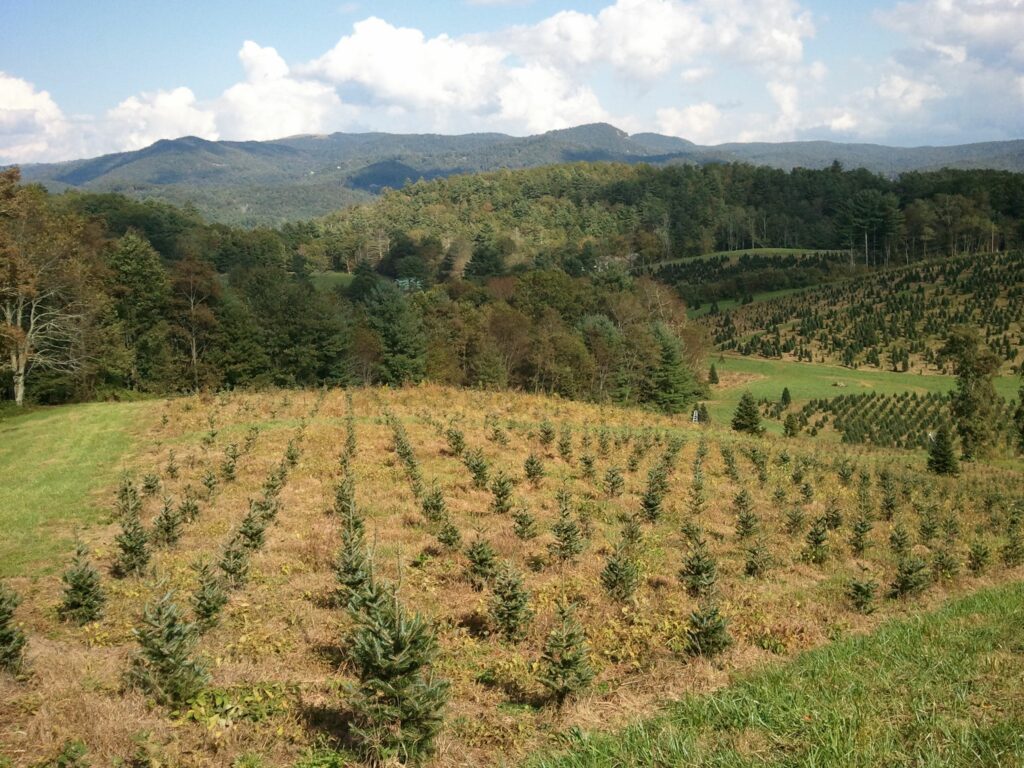
Small trees
Scouting all ages of trees. The emphasis of scouting changes through the rotation. The first couple of years after setting, groundcover management, fertility, and determining the cause of poorly growing or dying transplants are the main goals of scouting. As trees get bigger but still several years from harvest, the main goal is to track developing problems such as elongate hemlock scale, rosette bud mites, or even fertility problems. Trees to be harvested that year or the following year require more scouting to determine if cosmetic pests need to be controlled or if regulatory pests, which might restrict the sale of trees in some areas, are present.
Scouting blocks. A block is a scouting unit of trees planted at the same time and managed the same way at any given farm. It may comprise of a few hundred to a couple of thousand trees. It is best to break fields of several acres of the same-aged trees into smaller blocks for scouting purposes based on field roads. If blocks include mixed-aged trees, it is important to scout for pests in all sizes of trees.
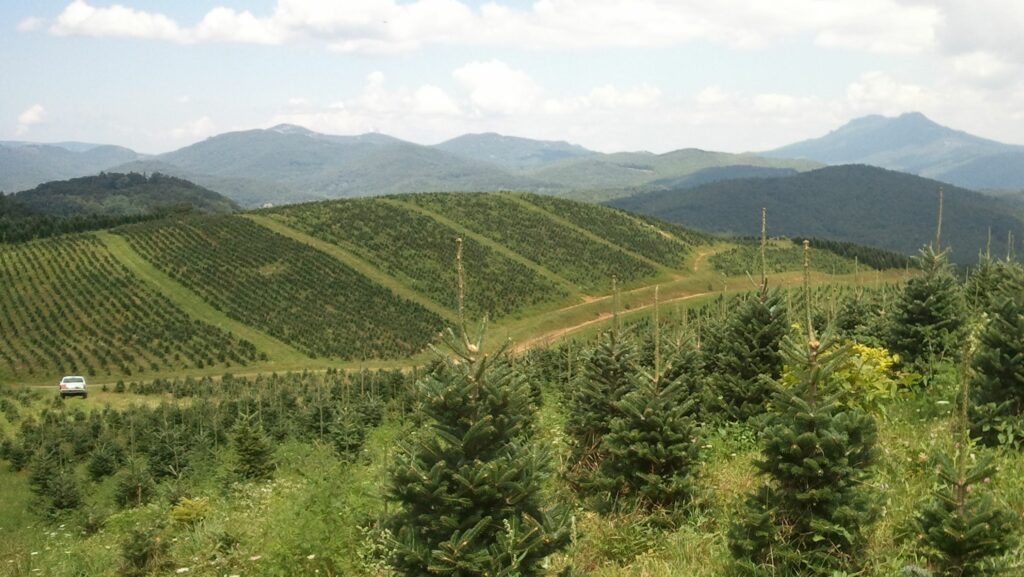
Field laid out in blocks
Walking the block. Many pests scouted for are small and only found on a few plants out of hundreds. Therefore, it is important to cover the entire block while scouting and to take different paths through the block with each scouting trip. To accomplish this, you might want to walk the entire length of a set number of rows, or take a random walk circling through the field, or follow a zigzag pattern. Each time the block is scouted, take a different path.
For most pests, you will need to sample 10 to 20 trees per block. If farms of more than two acres are scouted as a single block (same age trees scouted the same way), increase the number of trees sampled.
Special consideration is needed in fields treated with mistblowers because of the potential of uneven spray coverage. Look at some trees near the spray road and some in the interior of the block and furthest away from the road. Take samples or make observations from the side of the tree closest to the sprayer and some from the side away from the sprayer. In fact, it’s a good idea in any field to vary which side of the tree samples are taken from.
Choosing trees to sample. While scouting, look for trees with symptoms of pests or problems. This can include dead trees, dead branches, wilted shoots, trees with crooked tops, yellow or off-color foliage, or poor growth. Also sample trees showing no symptoms of pests or problems that are chosen at random. In this way, you can both diagnose problems and catch pests before they case damage.
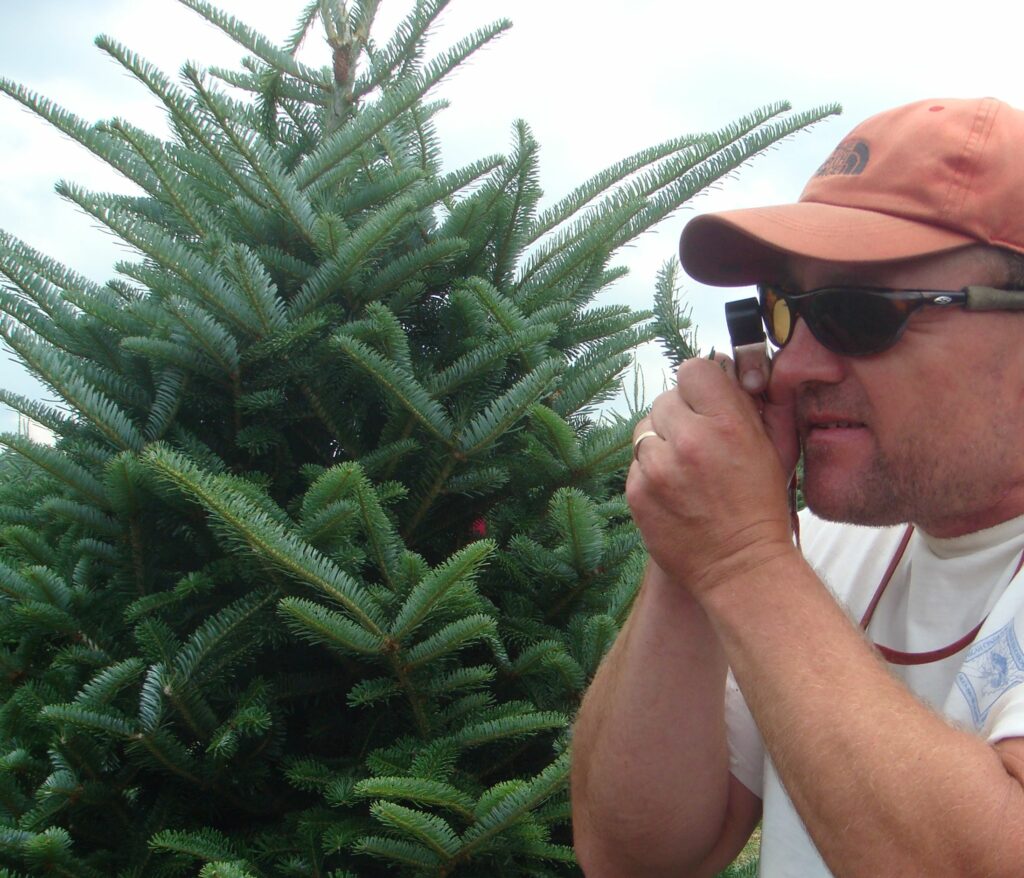
Examining shoot
Looking at shoots. Remove smaller shoots (6 inches or less) of most current growth from the lower half of the tree as this is where most pests are found. Be sure to remove the entire shoot to where it attaches to the previous year’s growth. Scan the shoot both front and back with a magnifying lens for pests and predators. This is the best way to find mites and twig aphid eggs.
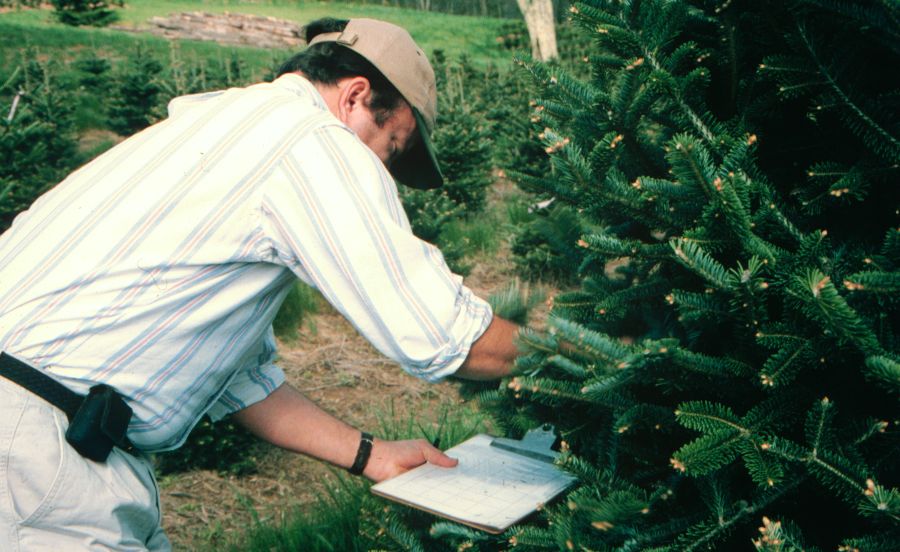
Beating foliage
Taking foliage beats. Beat tree foliage over a plate or paper to dislodge pests and predators. Foliage beats are the best way to scout for twig aphids and predators as you are sampling multiple branches at once. Examine whatever falls out with a hand lens to make positive identifications. Many insects can fall out of trees, making it hard to know what’s important and what isn’t. For instance, thrips, springtails, and bark lice are insects that can often be found in high numbers on Christmas trees but do not cause tree damage or reduce pest numbers.
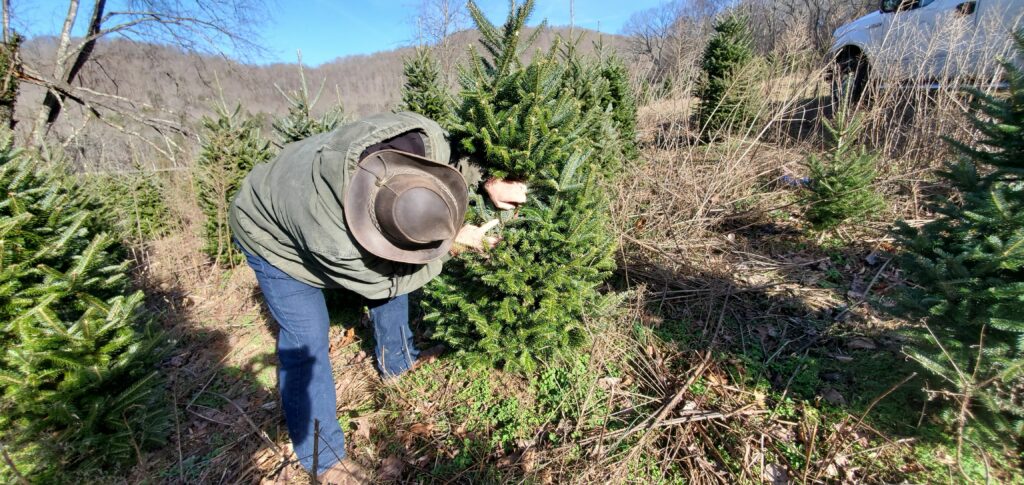
Scouting for scales
Assessing the underside of foliage. Because they live on the underside of foliage, one of the hardest pests to scout for are scales. Check trees with mottled foliage or that have a white cast to it due to the male elongate hemlock scale. But also check trees at random that show no outward sign of scales. Lift up branches, starting at the bottom of the tree and working your way to the top of the tree to determine if scales are present. Scales will also sometimes fall off onto beat plates when looking for other pests.
Scouting from a vehicle. If blocks and fields are large, it makes sense to scout from a vehicle. Many problems can be spotted while driving through a farm such as dead or discolored trees or trees with crooked tops. Nevertheless, it’s important to get out and walk from farm roads into the interior of blocks to look for pests. On each scouting trip stop in different areas and walk through different groups of trees.
Hot spot scouting. Though most of the time when scouting, you want to make random observations and cover the entire field, it is also a good idea to mark problem areas to make further observations. The principle behind hot spot scouting is to make repeated visits to a few small and specific areas of the field that tend to have early or recurring pest problems. Hot spot scouting can also be used to determine the size and stage of weeds to time herbicide treatments, or to monitor the effects of weather on spider mite populations or foliar diseases. In some cases, such as scouting for rust mites, frequent trips over several weeks may be necessary as a pest problem develops. After an insecticide treatment, revisit the hot spot to determine how well treatments worked. Identify the hot spot during the course of normal scouting and mark it with flagging and on a field map.
Tools for scouting. It takes only a few tools to scout, but all are important.
- Hand-held magnifying lens with 5X to 15X power
- Laminated paper, plastic plate, or something else to beat the foliage over
- Flagging to mark problem trees
- Plastic bags to keep samples of damaged shoots or insects that cannot be identified in the field
- Permeant marker to label flags and specimen bags
- Clippers for shoot and branch removal
- Pocketknife for removing shoots and bark samples
- Counter to keep track of the number of shoots sampled
- Cell phone to take photos, record GPS positioning, and find pest information on the internet
- Cell phone attachment to take photos of pests with magnification
- Coin to place beside pest specimen when taking photographs so that others know pest size
- Maps of fields to record problem areas
- Scouting sheets to record scouting results
- The only other tool needed for scouting is time. You have to make time to scout. It doesn’t take long – but you have to do it consistently.
The scouting calendar. How frequently you need to scout depends on the pests that are in your area and the market you are producing trees for. Of course, you can observe pest problems any time you are working in your trees, but it is still important to have dedicated scouting trips to assess pests.
January – March
- Review scouting notes from previous year.
- Learn if gypsy moth, spotted lanternfly, and other pests of regulatory importance are currently found in your area.
- Get a jump on scouting by evaluating twig aphid eggs and spider mite eggs in go-to-market trees and do thorough scout for elongate hemlock scale in all fields as weather permits.

Scouting trees different times of the year
April
- Once twig aphid eggs have hatched, scout for aphids in go-to-market trees. While assessing twig aphids also:
- Assess rust mite activity.
- Observe when spider mites start to hatch and become active.
- Take note of when predators are first observed.
- Determine the population and height of winter annuals and perennials. Determine the need for and timing of the first chemical mowing of the season.
- Assess activity of honeybees foraging in spring flowers such as mustard and purple deadnettle if trees are to be treated for twig aphids with pesticides having honey bee label restrictions.
May – June
- Scout after twig aphid treatments to learn how well they worked. If considering retreating, also assess the presence of predators. If predators are found, retreatment may cause more harm than good.
- Assess the height of established groundcovers and Fraser fir bud swell to determine if a chemical mowing treatment would now be appropriate.
- If treated previously for elongate hemlock scale, determine if scales are moving onto new growth.
- In fields with Cryptomeria scale, start scouting for crawlers.
July – September
- Assess trees for activity of male elongate hemlock scales causing white discoloration to foliage.
- Do thorough scouting for scale by lifting up branches to look at the underside of needles.
- Evaluate trees for balsam woolly adelgid by looking for crooked tops.
- In areas where rosette bud mites are a problem, evaluate incidence of damaged buds.
- Get a jump on scouting next spring by evaluating twig aphid eggs.
- Monitor for spider mites if weather is dry.
- Watch for late emerging annuals such as pigweed, barnyard and foxtail grasses. Also map location of problem weeds such as samplings, briars, and vines to be controlled once trees harden off.
- Dig holes to scout for white grubs in fields where seedlings will be planted.
- Take soil samples – ship to N.C. Department of Agriculture and Consumer Services before Thanksgiving to avoid processing costs.
October – November
- Keep monitoring for spider mites if weather is dry.
- Scout for Cinara aphid in harvested trees.
- While harvesting brush and trees, check for incidence of scales in materials to be shipped to areas with concern for scales.
- Take plant tissue samples.
- Take soil samples – ship to NCDA&CS before Thanksgiving.
Harvest
- Teach crews to recognize Cinara aphids in trees
- If shipping to areas with concern about scales or other post-harvest pests, monitor pest presence in tips and trees.
For the complete Fraser fir scouting manual for western North Carolina, see Scouting Manual.


